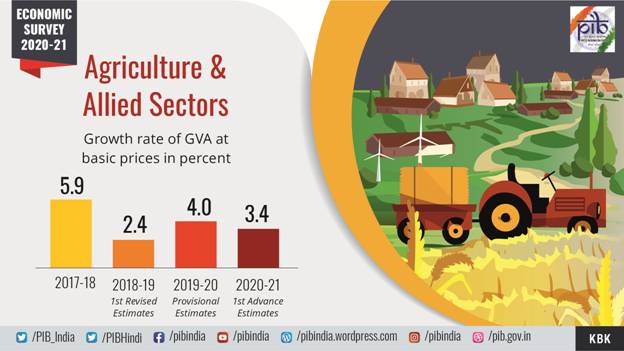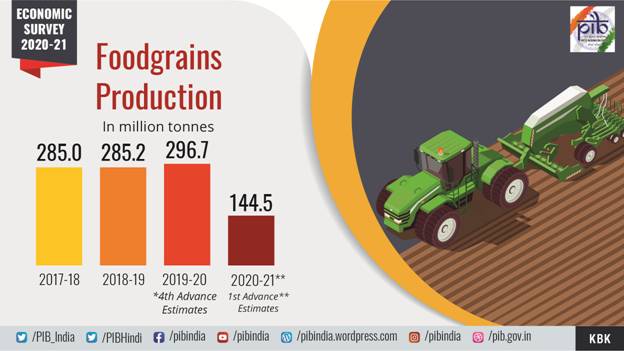Indian Agriculture contributes to green shoots of the Indian Economy with a Growth Rate of 3.4 Per Cent Despite COVID-19 Pandemic
Indian Agriculture contributes to green shoots of the Indian Economy with a Growth Rate of 3.4 Per Cent Despite COVID-19 Pandemic
India’s agricultural sector has shown its resilience amid the adversities of COVID-19 induced lockdowns. The Agriculture and Allied activities clocked a growth of 3.4 per cent at constant prices during 2020-21(first advance estimate) says the Economic Survey.The Union Minister for Finance & Corporate Affairs, Smt Nirmala Sitharaman presented the Economic Survey 2020-21 in Parliament today.
The Economic Survey observes that as per the Provisional Estimates of National Income released by CSO on 29th May, 2020, the share of Agriculture and Allied Sectors in Gross Value Added (GVA) of the country at current prices is 17.8 per cent for the year 2019-20.

Record Foodgrain Production
According to the Economic Survey in the Agriculture year 2019-20 (as per Fourth Advance Estimates), total food grain production in the country is estimated at record 296.65 million tonnes which is higher by 11.44 million tonnes than the production of food grain of 285.21 million tonnes achieved during 2018-19.

Agricultural Exports
The Ecnomic Survey notes that in 2019-20, India’s agricultural and allied exports amounted to approximately Rs. 252 thousand crores. The major export destinations were USA, Saudi Arabia, Iran, Nepal and Bangladesh. The top agriculture and related products exported from India were marine products, basmati rice, buffalo meat, spices, non-basmati rice, cotton raw, oil meals, sugar, castor oil and tea. While India occupies a leading position in global trade of aforementioned agri-products, its total agri-export basket accounts for a little over 2.5 per cent of world agri-trade.
Minimum Support Price
The Economic Survey says that “The Union Budget for 2018-19 had announced that MSPs would be kept at the level of 1.5 times of the cost of production. On the basis of the above-mentioned principle, Government recently increased the MSPs for all mandated kharif and rabi crops for 2020-21season.”
Agricultural Reforms
On recent agricultural reforms the Economic Survey says “The three agricultural reform legislations are designed and intended primarily for the benefit of small and marginal farmers which constitute around 85 per cent of the total number of farmers and are the biggest sufferer of the regressive APMC regulated market regime. The newly introduced farm laws herald a new era of market freedom which can go a long way in the improvement of farmer welfare in India.”
Aatma Nirbhar Bharat Abhiyan
The Economic Survey observes that the major announcements for agriculture and food management under the Atma Nirbhar Bharat Abhiyan have been Rs. 1 lakh crores Agriculture infrastructure fund; Rs. 10,000 crores scheme for Formalisation of Micro Food Enterprises (MFE); Rs. 20,000 crores for fisherman through Pradhan Mantri Matsya Sampada Yojana (PMMSY); National Animal Disease Control Programme; Animal Husbandry Infrastructure Development Fund- Rs. 15,000 crores; Reforms in Essential Commodities Act, Agriculture Marketing and Agriculture Produce Pricing and Quality Assurance; PM Garib Kalyan Ann Yojana; One Nation One Ration Card.
Agricultural Credit
The Economic Survey notes “Given the large proportion of resource constrained small and marginal farmers in India, timely availability of adequate credit is fundamental for the success of farming activities.” The agricultural credit flow target for the year 2019-20 was fixed at ₹13,50,000 crores and against this target the achievement was ₹13,92,469.81 crores. The agriculture credit flow target for 2020-21 has been fixed at ₹15,00,000 crores and till 30th November, 2020 a sum of ₹ 9,73,517.80 crores was disbursed. The Economic Survey notes that the Agriculture Infrastructure Fund announced as a part of Atma Nirbhar Bharat Abhiyan will further boost credit flow to the agriculture sector.
According to the Economic Survey, consequent upon budget announcement on inclusion of livestock sector in Kisan Credit Card in February 2020, 1.5 crores dairy farmers of milk cooperatives and milk producer companies’ were targeted to provide Kisan Credit Cards (KCC) as part of Prime Minister’s Atma Nirbhar Bharat Package. As of mid January 2021, a total of 44,673 Kisan Credit Cards (KCCs) have been issued to fishers and fish farmers and an additional 4.04 lakh applications from fishers and fish farmers are with the banks at various stages of issuance.
Pradhan Mantri Fasal Bima Yojana
The Survey observes that Pradhan Mantri Fasal Bima Yojana (PMFBY) is a milestone initiative to provide a comprehensive risk solution at the lowest uniform premium across the country for farmers. The PMFBY covers over 5.5 crore farmer applications year on year. As on 12th January, 2021, claims worth Rs. 90,000 crores have already been paid out under the Scheme. Aadhar seeding has helped in speedy claim settlement directly into the farmers’ accounts. Even during COVID-19 lock down period nearly 70 lakh farmers benefitted and claims worth Rs. 8741.30 crores were transferred to the beneficiaries.
PM-KISAN
The Economic Survey says “An amount of `18000 crore have been deposited directly in the bank account of 9 crore farmer families of the country in December, 2020 in the 7th installment of financial benefit under the PM-KISAN scheme.”
Livestock Sector
Regarding Livestock Sector the Economic Survey says “The livestock sector grew at CAGR of 8.24 per cent during 2014-15 to 2018-19. As per the estimates of National Accounts Statistics (NAS) 2020 for sector wise Gross Value Added of Agriculture and allied sector, the contribution of livestock in total agriculture and allied sector GVA (at Constant Prices) has increased from 24.32 per cent (2014-15) to 28.63 per cent (2018-19). Livestock sector contributed 4.19 per cent of total GVA in 2018-19.”
Fisheries
The Economic Survey notes that Fish production in India has reached an all-time high of 14.16 million metric tons during 2019-20. Further, the Gross Value Added (GVA) by the Fisheries sector to the national economy stood at ₹2,12,915 crores constituting 1.24 per cent of the total national GVA and 7.28 per cent of the agricultural GVA.
Pradhan Mantri Garib Kalyan Anna Yojana
The Economic Survey describes that “During the Financial Year 2020-21, allocation of foodgrains has been done through two channels- under National Food Security Act (NFSA) and Pradhan Mantri Garib Kalyan Anna Yojana (PM-GKAY) scheme. At present NFSA is being implemented in all the 36 States/UTs and they are receiving monthly allocation of foodgrains under NFSA. Under Pradhan Mantri Garib Kalyan Package as part of the economic response to COVID -19, Government of India launched the Pradhan Mantri Garib Kalyan Anna Yojana (PM-GKAY) scheme for additional allocation of foodgrains from the Central Pool at the rate of 5 kg per person per month free of cost for all the beneficiaries covered under Targeted Public Distribution System (TPDS) (i.e.,beneficiaries under Antyodaya Anna Yojana & Priority Households).” Under the Pradhan Mantri Garib Kalyan Anna Yojana, 80.96 crores beneficiaries were provided additional foodgrains, i.e. above the NFSA mandated requirements, of 5 kg per person per month free of cost till November, 2020. Over 200 LMT of foodgrains were provided amounting to a fiscal outgo of over Rs. 75000 Crores. Also, under Atma Nirbhar Bharat Package, 5 kg per person per month was distributed for four months (May to August) to benefit approximately 8 crores migrants who are not covered under NFSA or state ration card entailing subsidy of Rs. 3109 crores approximately.
Food Processing Industries
The Economic Survey notes that during the last 5 years ending 2018-19, Food Processing Industries (FPI) sector has been growing at an Average Annual Growth Rate (AAGR) of around 9.99 per cent as compared to around 3.12 per cent in Agriculture and 8.25 per cent in Manufacturing at 2011-12 prices

Comments
Post a Comment